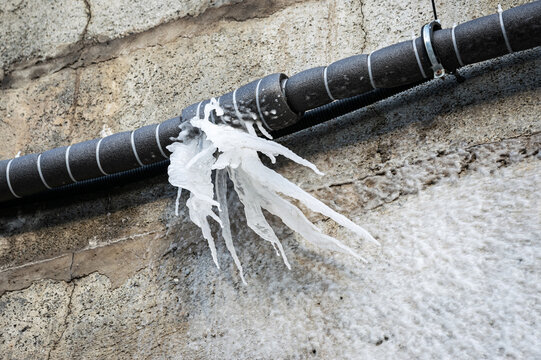Protecting Your Pipes from Cold Weather Damage: Critical Strategies
Protecting Your Pipes from Cold Weather Damage: Critical Strategies
Blog Article
We have discovered this great article about Helpful Tips to Prevent Frozen Pipes this Winter directly below on the web and believe it made perfect sense to share it with you on this site.

Winter can wreak havoc on your plumbing, especially by freezing pipelines. Here's exactly how to prevent it from happening and what to do if it does.
Intro
As temperatures drop, the danger of icy pipelines rises, potentially bring about expensive repair work and water damages. Comprehending how to avoid frozen pipes is critical for home owners in cold climates.
Recognizing Icy Pipes
What triggers pipelines to ice up?
Pipelines freeze when exposed to temperature levels listed below 32 ° F (0 ° C) for expanded periods. As water inside the pipes freezes, it increases, taxing the pipeline wall surfaces and possibly causing them to burst.
Risks and damages
Icy pipelines can bring about supply of water interruptions, residential property damage, and expensive repairs. Burst pipes can flooding homes and trigger comprehensive structural damages.
Indications of Frozen Pipes
Determining icy pipelines early can avoid them from breaking.
Just how to identify icy pipes
Look for reduced water circulation from taps, unusual smells or noises from pipes, and noticeable frost on exposed pipelines.
Prevention Tips
Shielding at risk pipes
Cover pipelines in insulation sleeves or use warm tape to secure them from freezing temperature levels. Concentrate on pipes in unheated or outside locations of the home.
Heating methods
Maintain indoor rooms appropriately heated up, specifically locations with pipes. Open cabinet doors to enable cozy air to flow around pipelines under sinks.
Shielding Exterior Plumbing
Garden hoses and outdoor faucets
Disconnect and drain pipes yard tubes prior to wintertime. Set up frost-proof faucets or cover outdoor taps with shielded caps.
What to Do If Your Pipelines Freeze
Immediate actions to take
If you presume frozen pipelines, maintain faucets open to ease pressure as the ice thaws. Utilize a hairdryer or towels soaked in warm water to thaw pipes slowly.
Long-Term Solutions
Architectural changes
Consider rerouting pipelines far from exterior wall surfaces or unheated locations. Add additional insulation to attic rooms, cellars, and crawl spaces.
Upgrading insulation
Buy high-quality insulation for pipes, attics, and walls. Proper insulation helps keep regular temperature levels and reduces the risk of frozen pipes.
Final thought
Protecting against icy pipelines calls for positive steps and quick responses. By understanding the reasons, indications, and preventive measures, home owners can secure their pipes throughout winter.
6 Proven Ways to Prevent Frozen Pipes and Protect Your Home
Disconnect and Drain Garden Hoses
Before winter arrives, start by disconnecting your garden hoses and draining any remaining water. Close the shut-off valves that supply outdoor hose bibs and leave the outdoor faucet open to allow any residual water to drain. For extra protection, consider using faucet covers throughout the colder months. It’s also important to drain water from any sprinkler supply lines following the manufacturer’s directions.
Insulate Exposed Pipes
Insulating your pipes is an effective way to prevent freezing. Pipe insulation is readily available at home improvement stores and is relatively inexpensive. Pay close attention to pipes in unheated areas such as the attic, basement, crawl spaces, or garage. Apply foam insulation generously to create a buffer against the cold. You can also wrap your pipes in heat tape or thermostat-controlled heat cables for added warmth.
Seal Air Leaks
Inspect your home for any cracks or openings that could let in cold air. Seal any holes around the piping in interior or exterior walls, as well as the sill plates where your home rests on its foundation. Additionally, make sure to keep your garage door closed unless you’re entering or exiting. Leaving it open creates a significant air leak that can lead to frozen pipes.
Allow Warm Air Circulation
During cold snaps, it’s essential to allow warm air to circulate evenly throughout your home. Leave interior doors ajar to promote better airflow. Open kitchen and bathroom cabinets to help distribute heat consistently around the rooms. If you have small children or pets, be sure to remove any household chemicals or potentially harmful cleaners from open cabinets for safety.
Let Faucets Drip
A small trickle of water can make a big difference in preventing ice formation inside your pipes. When temperatures drop significantly, start a drip of water from all faucets served by exposed pipes. This continuous flow helps prevent the water from freezing. Additionally, running a few faucets slightly can relieve pressure inside the pipes, reducing the chances of a rupture if the water inside does freeze.
https://choateshvac.com/6-proven-ways-to-prevent-frozen-pipes-and-protect-your-home/

I hope you enjoyed reading our piece about Winter Plumbing Precautions: Preventing Frozen Pipes. Thanks a ton for taking time to read through our post. Appreciated our blog? Please quickly share it. Help another person check it out. Thanks a lot for taking the time to read it.
Services Report this page